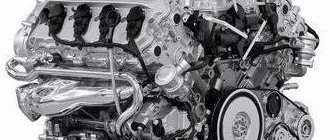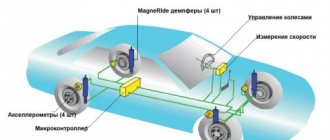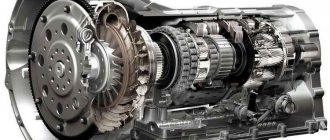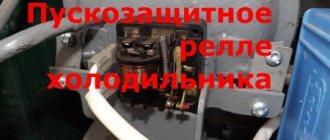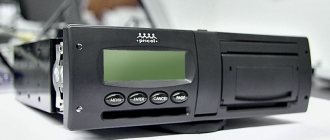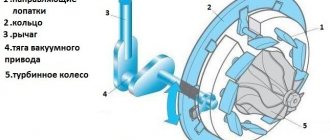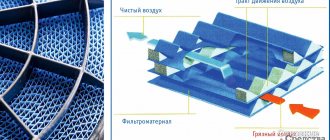A wheel lock for trucks is used both to protect against theft and to prevent improper parking of trucks or to arrest and detain a vehicle.
The blocker is designed for installation on the rear dual wheels of trucks to prevent the movement of vehicles. Installed on all types of cars, incl. for "Gazelle", "Bulls", KamAZ, etc., as well as for wheels of trucks, trailers, special and construction equipment. There are no restrictions on the diameter and width of the wheel.
The blocker can serve as:
- anti-theft device (especially since anti-theft alarms, traditional for individual passenger vehicles, are not used on cargo vehicles);
- as a non-removable anti-recoil stop;
- as a means used by law enforcement or municipal authorities to block traffic when parking, moving or operating a cargo vehicle is violated.
The principle of operation of the cargo blocker: a triangular prism (heel), made of a steel rod with a diameter of 20 mm, is installed under the dual rear wheels of the car and prevents its movement. Fastening to the car wheel is carried out using a chain and is locked with a lock (steel body and hardened shackle). Access to fastening elements is structurally difficult. Compact when not in use. The time for installing and removing the blocker is no more than 1 minute.
Parameters (Technical Specifications) of wheel lock for trucks:
Dimensions: 240x240x350 mm; Weight: 10 kg; Minimum wheel size: (on which BKU-G is installed) – 175/75 R16 – corresponds to the Gazelle; Maximum wheel size: (on which BKU-G is installed) – 320/80 R20 – corresponds to the heaviest KAMAZ; Maximum load on the wheel: 6500 kg (the figure is taken from the specification of the wheel chocks - there are no heavier ones) - the heaviest KAMAZ 6520 - 33100 kg (6 wheels) - load on the wheel 5516 kg.
Impeccable protection or psychological calmness
Wheel locks are not as popular among car owners as all other means of mechanical protection. First of all, this is due to the fact that installing them in the working position is a rather uncomfortable task. But nevertheless, they are still in demand both by car owners and punitive organizations. It will be convenient to divide all these devices into groups of different popularity:
- The first, one of the most popular groups, includes wheel lockers, fixed directly to their rubber. These are the so-called “crabs” among the people. They are extremely versatile and make it impossible to access the mounting locations of the disk itself; The disadvantages include the possibility of their dismantling by bleeding air from the wheel. In addition, with a weight close to 10 kg. It is difficult to place them while keeping both your hands and outer clothing clean. For ladies, these are generally prohibitive problems;
- they do not have a rigid fastening - the size of the fixing pin is significantly smaller than the size of the ventilation window of the disk;
Important: regularly using wheel blockers is completely unrealistic. But as a means of periodically protecting a car, they have a right to exist.
Only extremely thrifty people, whose concern for the safety of their car has reached the level of professional psychosis, will be able to carry wheel lockers with them throughout the year for regular use. When it comes to the immediate need to protect against attempted theft, wheel lockers can provide such a service. But they are unlikely to help against theft using a tow truck.
Installation of BKU-G on a wheel
- Pass the chain through the top hole in the stop plate and install the lock on one of the outer links of the chain.
- Place the stop under the dual wheel against the movement of the vehicle so that the plate is on the side of the wheel.
- Place the free end of the chain on top into the gap between the wheels.
- Pass the hook through the bottom hole of the plate and then from below into the gap between the wheels.
- Hook the hook onto the outermost link of the chain and pull the chain through the hole in the plate.
- Tension the chain and connect the ends of the chain using a lock.
Their advantages and disadvantages
It is advisable to use all mechanical means as an addition to the main alarm systems.
The advantages of mechanical devices are:
- low cost of the device;
- low cost of installing the device in case of using hidden locks;
- independence from vehicle electronics. Many alarms automatically turn off when there is no power source (that is, to turn off the alarm, you just need to remove the car battery).
Mechanical devices can only be turned off using a special key (master key) or an additional electronic device.
The negative qualities of mechanical protective equipment are:
- the need to constantly install the device when leaving the car and remove the device before driving. Such actions take up the driver’s personal time and cause additional problems;
- If the key is lost, it is almost impossible to make a new one. You also cannot simply cut down the device or drill out the lock cylinder.
Thus, if the car owner loses his keys, he faces big problems that can only be solved by professionals for a fairly decent amount of money.
Installation of BKU-G on a wheel with protection against removal
- Attach two chains to a long chain using carabiners at a distance of 25-40 cm (depending on the diameter of the wheel).
- Pass the chain through the top hole in the stop plate and install the lock on one of the outer links of the chain.
- Place the stop under the dual wheel against the movement of the vehicle so that the plate is on the side of the wheel.
- Place the free end of the chain on top into the gap between the wheels.
- Pass the hook through the bottom hole of the plate and then from below into the gap between the wheels.
- Hook the hook onto the outermost link of the chain and pull the chain through the hole in the plate.
- Tension the chain and connect the ends of the chain using a lock.
- Fasten the ends of two short chains to the holes in the plate in places corresponding to the diameter of the wheel.
- Insert the remaining chain into the free hole of the plate, tighten and secure with a lock.
How are anti-theft systems controlled?
Immobilizer key
VERY simple and most common method. The ignition key contains a miniature electronic chip that “allows” the electronics to start the engine as soon as the key is in the lock. Almost always, such an immobilizer is included in the factory equipment of the car. It is effective against simple methods of theft, for example, when the criminal uses a regular duplicate key without an electronic chip or tries to connect the wires directly.
Unfortunately, this immobilizer becomes useless if the ignition key is stolen.
Main advantages of BKU-G
- installation on the wheels of various trucks;
- quick and easy installation on the wheel;
- light weight and compactness;
- access to the locking elements is difficult (protection is provided against drilling and folding of the lock cylinder, exposure to acid and cryogenic substances);
- can serve as a non-removable wheel chock;
Wheel lock for trucks can only be purchased from.
All our products are patented. Illegal use, copying and production of patented products is punishable by law (Article 147 of the Criminal Code of the Russian Federation).
During unloading and loading operations in Moscow at docking stations, there is always a high risk of damage to transported goods and accidents. Typically, communication between warehouse staff and truck drivers leaves much to be desired.
It is possible for the truck to leave the dock prematurely when the work is not yet completed, as well as for the vehicle to move spontaneously.
Pedal locks
In search of effective MPUs, you need to pay attention to pedal locking devices. They belong to the list of the oldest car theft protection systems that limit the movement of the pedals. The principle of operation is quite simple and involves fixing the mechanisms in the upper extreme position. The mechanical organ is installed on the clutch pedal and connected to the lock. In working condition, the limiting element bracket is connected to the body parts, and the locking rod prevents gear shifting. By mounting this device, you can stop the gas pedal.
Advanced models of such locks support combined locking of the steering wheel and pedals, prohibiting intruders from driving the vehicle. The lock moves along a guide, so it is suitable for different car models.
The advantages of combined devices include:
- Ease of operation.
- Maintaining protection at zero battery charge level.
- There is no need to install different guides and additional components.
- Universal purpose. One unit is suitable for different car models.
But pedal locks also have disadvantages. One of the most significant is the poor build quality, since most parts are made in China.
To cut the mechanism, just use a hacksaw.
Car owners also highlight the following weaknesses:
- It is not difficult to bite through the element that limits the steering wheel and pedals. If cars are equipped with an adjustable steering column, drivers must constantly lower it to the lower position. If you do not do this, the mechanism can be removed in a couple of seconds. If there are adjustable pedals, they are left in the up position.
- When installing a lock on the brake pedal, it is necessary to further limit access to the parking brake. Otherwise, the car will be stolen at minimum speed, after which the criminal will cut the blocker.
- If the car has an automatic transmission, it can be driven at idle speed.
Mechanical devices are not known for their high degree of reliability, so their main role is as an addition to standard automotive protection systems.
COMBILOK truck restraint system
Stertil COMBILOK is an innovative, patented wheel locking system. This product characterizes itself as a reliable, safe and highly intelligent vehicle restraint system. It allows you to automatically lock the wheels of the truck from the control panel, thereby preventing any movement of the vehicle.
- Automatic blocking
- easy to install
- lock in 30 seconds
- does not damage the wheels
There is also a visual and audio warning system for wheel locking and unlocking, which allows the driver to know exactly when work has begun and completed.
Design and types of blockers
As a rule, mechanical locks prevent an attacker from accessing various elements of the car: doors, steering wheel, gearbox, pedals. Experts assess this protection as very reliable. The hijacker may simply not be ready for such an obstacle on the way.
Car theft and protection systems
According to the installation method, blockers are divided into two types:
- stationary;
- removable.
Stationary ones are built into the body or mechanism of a car element. There is no way to get to them without serious dismantling. For example, a gearbox or steering column lock.
Removable bollards must be installed and then removed each time. This is inconvenient and takes some time. Their advantage is their affordable price.
How it works?
Thanks to the integrated wheel guides in the system, the vehicle is driven precisely and centered to the docking station. The operator then presses a button on the control system to lock the wheels, and thanks to the touch sensor, the system automatically detects the last rear wheel. The anti-roll stop is pressed tightly against the wheel under 50 bar of pressure, securing the vehicle in place. The wheel locking process takes only 30 seconds.
The wheel lock unit has an emergency stop button that can be operated manually to immediately deactivate the wheel lock.
On the control panel inside the dock, the operator can see when the system has locked the vehicle's wheels, notifying that unloading/loading work can begin.
After all unloading and loading operations have been carried out, the system operator will be able to unlock the truck by pressing one button. The wheel support returns to its original position, after which the green traffic light lights up, which notifies the driver that he can drive away and not wait for the COMBILOK to return to its place.
How to choose the right steering lock
How to choose a steering lock and not make a mistake? There is nothing unusual about choosing any gadget. Everything is quite simple and familiar. The steering wheel protection consists of a supporting base and a locking device with a secret locking mechanism:
- door lock;
- lock body – load-bearing base;
- its tongue is a locking device;
- larva – secret mechanism;
- steering wheel (axle) lock;
- load-bearing base - two coupling halves mounted on the steering wheel axis;
- locking device - a stopper of the mechanism inserted into the coupling when locked;
- secret mechanism - key or keyless;
- on the steering wheel (wheel);
- load-bearing base - a complex-shaped rod with a locking coupling, installed on the rim and spokes of the steering wheel;
- locking device - a stopper of the lock inserted into the coupling when locking;
- secret mechanism - key or keyless;
Having an idea of how to choose the best one means being sure that:
- it is suitable, according to its parameters, for installation on a specific car model;
- has the maximum degree of protection against burglary;
- there is no access to the fixing elements of the structure;
- it is made of durable stainless steels;
- its constipation mechanism has increased secrecy;
- it is easy to install on the car and convenient to use;
- A good feature would be a keyless design or an original key that prevents popular opening methods (bumping, master keys or rolls);
- the gadget itself has an aesthetically attractive appearance;
- polished metal;
- leather surface to match the color of the car interior;
- the presence of a leather cover for the fixing element and a branded key fob or locking sleeve.
Important: a leather cover will prevent the constant rattling of the steel part of the steering lock in the glove compartment or door pocket.
Safety First: Vehicle Restraint System
Ensuring safety during loading and unloading operations.
Do you want to avoid premature truck departures and minimize the risk of accidents and serious injuries during loading?
Stertil COMBILOK® product is a patented locking system for trucks and trucks, which has proven itself to be the most reliable, durable and effective system. Stertil COMBILOK® system is perfect for unloading not only trucks themselves, but also trailers.
The unique COMBILOK® vehicle locking system with wheel guides will make reloading work safe.
Main advantages:
– Prevents accidents and damage – Reliable operation with low maintenance costs – Ability to integrate the control mechanism with other equipment – Easy ground installation – Acoustic and optical signals when activated
Manufacturer
Stertil (Netherlands)
Optional: - wheel guide (opposite to design), - one traffic light, - one siren.
Transmission locks
High-quality mechanical protection against theft minimizes the likelihood of car theft, since it makes the car thief uncomfortable in committing a crime.
Mechanical devices are used as an additional accessory to a car alarm or immobilizer; even when installed independently, they perform their tasks well.
Devices that block the gearbox are among the most important and effective. They lock the transmission in reverse or “Parking”, preventing the criminal from starting the car.
The operating principle of such systems is quite simple. When a car thief gets into the car and even turns off the standard alarm, he immediately gets behind the wheel, trying to move. However, any attempts become unsuccessful.
Transmission locks are often used in conjunction with other mechanical anti-theft systems and are suitable for different vehicle models.
To ensure maximum protection, you must follow the installation rules and not deviate from the instructions. If installed correctly, the system blocks not only the gearshift lever, but also the shift mechanism link.
Increased security with integrated controls
The control unit can be integrated with other docking station equipment, such as a dock leveler or warehouse sectional doors . For example, you can have the truck automatically held until the leveler returns to the parking position.
To increase safety during loading and unloading and to prevent damage to equipment, we recommend that you always install wheel guides in front of the loading gate. The wheel guides are easy to install on concrete and require no maintenance.
The green/red light of the indicators on the control unit provides a clear understanding of whether the car is currently being held.
Advantages of mechanical anti-theft devices
Increasingly, in addition to electronic anti-theft systems, mechanical security devices are also being added to cars. And some car enthusiasts prefer only mechanical protection, considering it the most reliable. What is the difference between such protective installations?
Advantages:
- protection against remote hacking;
- a mechanical system implies an autonomous protection system that does not depend on electrical wiring and does not require an additional power source;
- reliable protection that cannot be hacked by any other means than mechanical force;
- Most of these devices are installed in places invisible from the street, which becomes a significant problem for intruders.
Prevent damage with the COMBILOK® wheel lock
The risk of damage to handling equipment, or the occurrence of accidents during loading and unloading operations, increases significantly if there is a time limit for performing these operations. Communication between warehouse staff and drivers in the cabs is often difficult, especially at night.
Premature departure from the dock while the body doors are open, or any "sliding" of the vehicle is not unusual. vehicle restraint system prevents these accidents in the workplace.
Biometric immobilizers
JUST like transponder systems, biometric devices are designed to protect the car owner in case of theft of keys and alarm fob. Their task is to identify the driver using fingerprints. To disable engine blocking, a registered user just needs to place his finger on the scanner to compare his fingerprint with the biometric samples registered in the system. In this case, additional electronic cards or key fobs are not required.
To recognize fingerprints in anti-theft systems, a so-called capacitive scanner is used. Unlike an optical sensor, which, as it were, “photographs” a finger, in a capacitive sensor the semiconductor device reacts to the number of protrusions and grooves of the finger. Their individual combination forms its own unique electrical signal, which the system compares with a standard stored in memory. The capacitive scanner is small in size and can be easily installed inside the car. Its reading surface is protected by a wear-resistant sealed coating. Please note that capacitive scanners “do not like” wet fingers (their optical counterparts, on the contrary, read worse from dry ones).
The biometric scanner can be additionally linked to the electromechanical hood lock. True, in this case, duplication of the system is necessary, because if the battery is discharged, it will be impossible to open the hood. Typically, in such a situation, electronic systems are supplemented by a safety cable located in a hidden place, and to remove it, you will need, for example, to jack up the car and remove the wheel.
The operating algorithm of immobilizers may be different. For example, the domestic WOODOO biometric system comes with two types of anti-theft relays. A simpler one - HOOK-UP - does not allow you to start the engine before receiving an authorization signal from the control unit, and the encoded signals themselves are transmitted through the standard electrical wiring of the car (thus, it is impossible to detect the unit using separate wires leading to it). In the housing of the more advanced WAIT UP relay there is a motion sensor that blocks engine operation when starting off.

